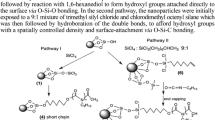Summary.
Silicon oxide or metal oxide clusters or small particles with polymerizable organic groups covalently bonded to their surface can be copolymerized with organic monomers by various polymerization techniques. Whereas the preparation and properties of the polymers reinforced by R 8Si8O12 have already been well investigated, analogous materials with incorporated transition metal oxide clusters are only beginning to show their potential as an interesting new class of inorganic-organic hybrid polymers. In the second part of the article, approaches are reviewed in which the inorganic building block serves as an initiator for polymerization reactions. This results in materials in which the organic polymer is grafted from an inorganic core. Most work has been done with surface-modified silica particles. Free radical polymerizations and atom transfer radical polymerizations with macroinitiators are summarized. The latter method results in polymeric particles in which an inorganic core is surrounded by an organic polymer shell. A new approach is the use of polyfunctional inorganic molecules or molecular clusters as initiators.
Similar content being viewed by others
Author information
Authors and Affiliations
Additional information
Received July 28, 2000. Accepted August 7, 2000
Rights and permissions
About this article
Cite this article
Kickelbick, G., Schubert, U. Inorganic Clusters in Organic Polymers and the Use of Polyfunctional Inorganic Compounds as Polymerization Initiators. Monatshefte fuer Chemie 132, 13–30 (2001). https://doi.org/10.1007/s007060170141
Issue Date:
DOI: https://doi.org/10.1007/s007060170141



